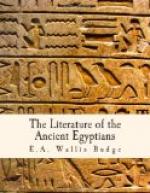[Footnote 5: The Air-god, the son of Keb and Nut.]
The ceremonies that followed concerned the dressing of the statue of the king and his food. Various kinds of bandlets and a collar were presented, and the gift of each endowed the king in the Other World with special qualities. The words recited by the priest as he offered these and other gifts were highly symbolic, and were believed to possess great power, for they brought the Double of the king back to this earth to live in the statue, and each time they were repeated they renewed the life of the king in the Other World.
II. The Liturgy of Funerary Offerings was another all-important work. The oldest form of it, which is found in the Pyramid Texts, proves that even under the earliest dynasties the belief in the efficacy of sacrifices and offerings was an essential of the Egyptian religion. The opening ceremonies had for their object the purification of the deceased by means of sprinkling with water in which salt, natron, and other cleansing substances had been dissolved, and burning of incense. Then followed the presentation of about one hundred and fifty offerings of food of all kinds, fruit, flowers, vegetables, various kinds of wine, seven kinds of precious ointments, wearing apparel of the kind suitable for a king, &c. As each object was presented to the spirit of the king, which was present in his statue in the Tuat Chamber of the tomb, the priest recited a form of words, which had the effect of transmuting the substance of the object into something which, when used or absorbed by the king’s spirit, renewed the king’s life and maintained his existence in the Other World. Every object was called the “Eye of Horus,” in allusion to its life-giving qualities. The following extracts illustrate the Liturgy of Funerary Offerings:
32. This libation is for thee, Osiris, this libation is for thee, Unas.[1] (Here offer cold water of the North.) It cometh forth before thy son, cometh forth before Horus. I have come, I have brought unto thee the Eye of Horus, that thy heart may be refreshed thereby. I have brought it and have set it under thy sandals, and I present unto thee that which flowed forth from thee. There shall be no stoppage to thy heart whilst it is with thee, and the offerings that appear at the command[2] shall appear at thy word of command. (Recite four times.)
[Footnote 1: The king who is identified with Osiris.]
[Footnote 2: The deceased who possessed the words of power uttered in the tomb the names of the offerings he required, and the offerings appeared forthwith.]
37. Thou hast taken possession of the two Eyes of Horus, the White and the Black, and when they are in thy face they illumine it. (Here offer two jugs of wine, one white, one black.)
38. Day hath made an offering unto thee in the sky. The South and the North have given offerings unto thee. Night hath made an offering unto thee. The South and the North have made an offering unto thee. An offering is brought unto thee, look upon it; an offering, hear it. There is an offering before thee, there is an offering behind thee, there is an offering with thee. (Here offer a cake for the journey.)




